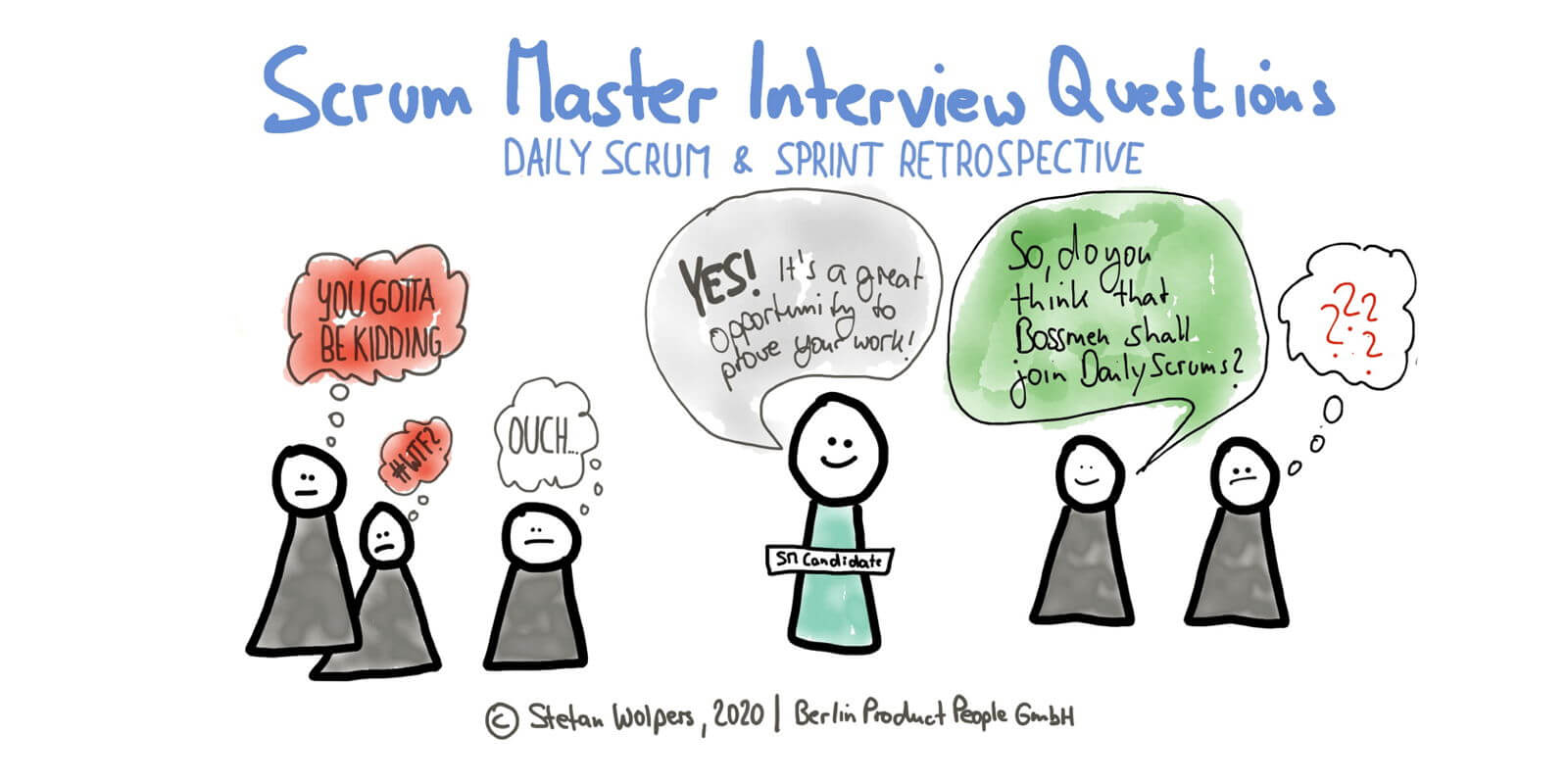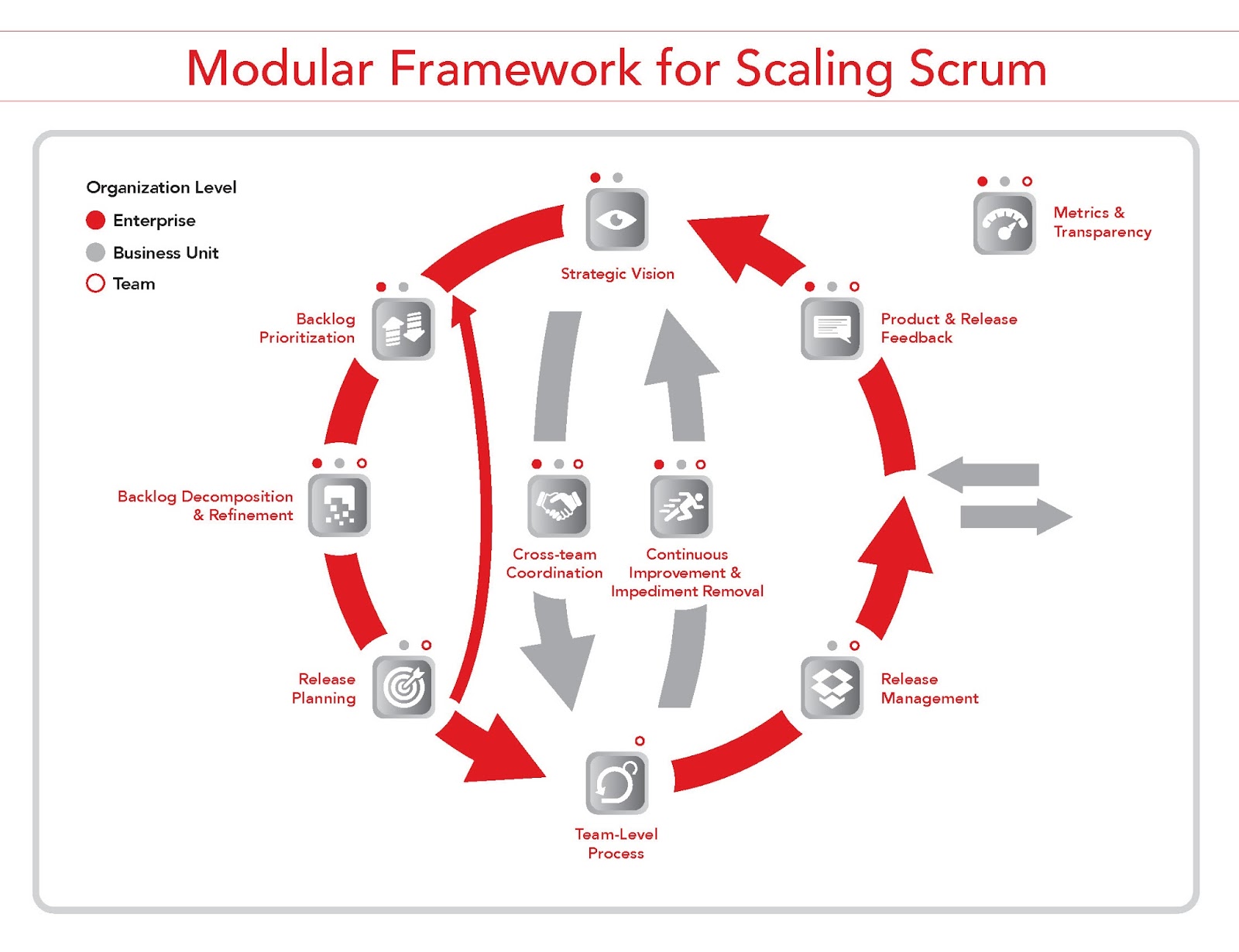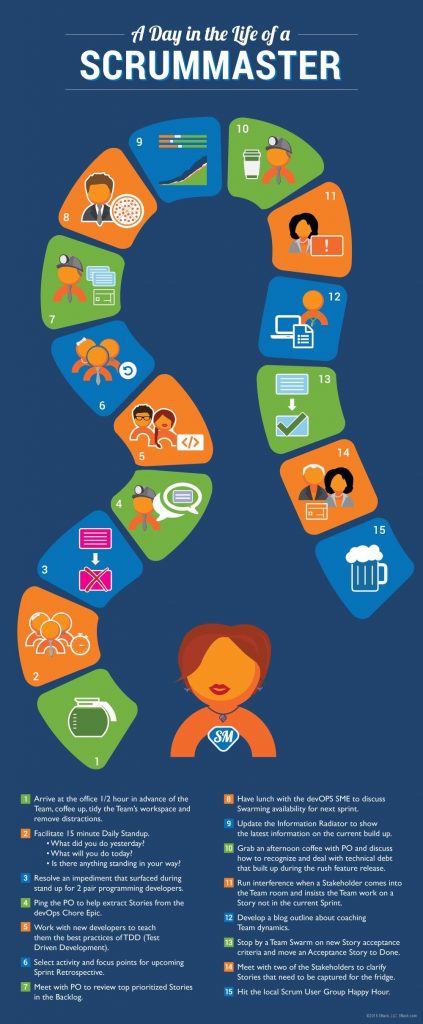What is Scrum and How Does it Work?
Scrum is an agile framework designed for managing and completing complex projects through iterative progress and collaboration. This lightweight, adaptive framework is widely used in software development and other industries to streamline workflows, enhance productivity, and improve product quality. The Scrum framework comprises three roles, three artifacts, and five events or ceremonies.
The three roles in Scrum are the Product Owner, the Scrum Master, and the Development Team. The Product Owner is responsible for defining and prioritizing the product backlog, representing the voice of the customer, and ensuring the team delivers value. The Scrum Master facilitates the Scrum process, removes impediments, and coaches the team on Scrum principles and practices. The Development Team consists of cross-functional members who collaborate to deliver potentially shippable increments of the product at the end of each Sprint.
The three artifacts in Scrum are the Product Backlog, the Sprint Backlog, and the Increment. The Product Backlog is a prioritized list of features, requirements, and bugs that need to be addressed. The Sprint Backlog is a subset of the Product Backlog items selected for the current Sprint, along with a plan for delivering the selected items. The Increment is the sum of all the Product Backlog items completed during a Sprint and all previous Sprints, which must be in a usable state and meet the agreed-upon Definition of Done.
The five Scrum ceremonies include the Sprint Planning, Daily Scrum, Sprint Review, Sprint Retrospective, and the Potentially Shippable Increment. Sprint Planning marks the beginning of a Sprint, where the team aligns on the goals, selects items from the Product Backlog, and creates the Sprint Backlog. The Daily Scrum is a short, daily meeting where the Development Team synchronizes and plans their work for the day. The Sprint Review is an opportunity for the Scrum Team and stakeholders to inspect the Increment and adapt the Product Backlog as needed. The Sprint Retrospective is a meeting for the Scrum Team to reflect on their performance and identify opportunities for improvement. Finally, the Potentially Shippable Increment is the culmination of the Sprint, where the team delivers a usable and potentially releasable product increment.
https://www.youtube.com/watch?v=RLFy9BoH6Sw
Why are Scrum Questions Important for Success?
Asking the right Scrum questions is crucial for ensuring project success, promoting transparency, and enhancing team communication. Scrum questions enable teams to identify areas for improvement, address challenges, and continuously learn and adapt. The Scrum Master plays a vital role in facilitating these discussions and fostering an environment where team members feel comfortable expressing their thoughts and concerns.
Scrum questions help teams clarify goals, prioritize tasks, and evaluate their performance. By asking questions, team members can gain a deeper understanding of the Scrum framework, their roles, and the expectations associated with each Sprint. Furthermore, Scrum questions promote critical thinking, problem-solving, and continuous improvement, ensuring that the team remains aligned and focused on delivering value.
Scrum questions also contribute to building trust and strengthening relationships within the team. By encouraging open communication and active listening, Scrum questions create a safe space for team members to share their ideas, concerns, and feedback. This, in turn, fosters a culture of collaboration, respect, and shared responsibility, where everyone feels valued and empowered to contribute to the project’s success.
In addition to promoting internal communication, Scrum questions can help teams manage stakeholder expectations and ensure that they are meeting the organization’s strategic objectives. By asking questions about project goals, progress, and risks, Scrum teams can maintain a clear line of sight between their work and the organization’s mission, vision, and values. This alignment is essential for ensuring that the team’s efforts are aligned with the organization’s overall strategy and that stakeholders remain informed and engaged throughout the project.
Common Scrum Questions and Answers
To gain a better understanding of Scrum and its core concepts, consider the following frequently asked Scrum questions and their answers:
What is a Sprint?
A Sprint is a time-boxed iteration, typically lasting 1-4 weeks, during which a Scrum Team commits to delivering a set of prioritized items from the Product Backlog. Sprints provide a framework for consistent, predictable delivery of valuable increments, allowing teams to inspect and adapt their progress regularly.
What is a Product Backlog?
The Product Backlog is a prioritized list of features, requirements, and bugs that need to be addressed to deliver a valuable product. It is a dynamic artifact that evolves as the team’s understanding of the product and its users deepens. The Product Owner is responsible for maintaining and prioritizing the Product Backlog.
What is a Sprint Backlog?
The Sprint Backlog is a subset of the Product Backlog items selected for the current Sprint, along with a plan for delivering the selected items. It is a collaborative effort between the Development Team and the Product Owner, outlining the work to be done during the Sprint. The Sprint Backlog provides transparency and visibility into the team’s progress and workload.
What is a Scrum Master?
The Scrum Master is a dedicated role responsible for facilitating the Scrum process, removing impediments, and coaching the team on Scrum principles and practices. The Scrum Master acts as a servant-leader, ensuring that the team adheres to Scrum values and principles, and that the Scrum framework is understood and implemented effectively.
What is a Definition of Done (DoD)?
The Definition of Done (DoD) is a shared understanding among the Scrum Team of the criteria that must be met for a Product Backlog item to be considered complete. The DoD typically includes requirements related to code quality, testing, documentation, and deployment, ensuring that the team delivers a consistent, high-quality Increment at the end of each Sprint.
What is a Sprint Review?
The Sprint Review is a meeting held at the end of each Sprint, where the Scrum Team and stakeholders inspect the Increment and adapt the Product Backlog as needed. The Sprint Review provides an opportunity for the team to demonstrate their progress, receive feedback, and align on the direction for the next Sprint.
How to Effectively Communicate Scrum Questions and Concerns
Open communication is essential for Scrum Team success. Team members should feel comfortable expressing their thoughts, ideas, and concerns. By fostering a culture of respect, trust, and active listening, Scrum Teams can effectively address Scrum questions and concerns, ensuring continuous improvement and alignment with project goals.
Create a Safe Environment
Establishing a safe environment is crucial for encouraging open communication. Team members should feel confident that their questions and concerns will be met with respect, understanding, and a genuine desire to help. Encourage vulnerability and empathy, and make it clear that everyone’s input is valuable and appreciated.
Use Appropriate Communication Channels
Scrum Teams should leverage various communication channels to address Scrum questions and concerns. The Daily Scrum is an excellent opportunity for team members to discuss their progress, identify potential issues, and coordinate their efforts. For more complex or sensitive topics, consider scheduling dedicated meetings or using collaboration tools to facilitate discussions.
Prepare for Discussions
Before raising Scrum questions or concerns, take the time to gather relevant information, examples, and data to support your points. Being well-prepared demonstrates respect for others’ time and a commitment to constructive dialogue. Encourage team members to do the same, ensuring that discussions are focused, productive, and valuable.
Practice Active Listening
Active listening is essential for effective communication. When addressing Scrum questions and concerns, team members should focus on understanding each other’s perspectives, asking clarifying questions, and providing thoughtful responses. By actively listening, team members can build trust, foster empathy, and promote a collaborative environment.
Emphasize Continuous Improvement
Scrum Teams should view Scrum questions and concerns as opportunities for continuous improvement. Encourage team members to regularly reflect on their performance, identify areas for growth, and propose solutions for addressing challenges. By emphasizing continuous improvement, Scrum Teams can maintain a forward-thinking, proactive approach to project management.
Scrum Questions for Retrospectives and Continuous Improvement
Sprint Retrospectives are essential Scrum ceremonies that enable teams to reflect on their performance, identify areas for improvement, and commit to actions that drive continuous learning and development. By asking the right Scrum questions during Retrospectives, teams can foster a culture of continuous improvement and maintain a strong focus on delivering value.
What Went Well During the Sprint?
Begin Retrospectives by discussing what went well during the Sprint. This question encourages team members to share their successes, celebrate achievements, and identify practices that contribute to efficient and effective collaboration. Examples of Scrum questions to ask include:
- “Which processes or tools helped us deliver value this Sprint?”
- “What did we do well in terms of communication and collaboration?”
- “Which team members or stakeholders provided valuable support or insights?”
What Could Be Improved?
After discussing successes, shift the focus to areas that require improvement. Encourage team members to be honest and constructive in their feedback, focusing on specific issues and potential solutions. Examples of Scrum questions to ask include:
- “What challenges or obstacles did we encounter during the Sprint?”
- “Where did we struggle in terms of communication, collaboration, or productivity?”
- “What aspects of our Definition of Done could be strengthened?”
What Actions Should We Take for the Next Sprint?
Conclude Retrospectives by identifying actionable steps that teams can take to address areas for improvement and build on their successes. Encourage team members to commit to specific tasks, assign ownership, and establish deadlines. Examples of Scrum questions to ask include:
- “What changes can we make to our processes, tools, or communication strategies?”
- “How can we better support each other and collaborate during the next Sprint?”
- “What skills or knowledge do we need to develop to enhance our performance?”
Scrum Questions for Scaling Agile Practices
Scaling Scrum to accommodate multiple teams or large organizations can present unique challenges, including coordination, alignment, and communication. By asking the right Scrum questions, teams can identify potential issues and implement strategies that promote successful scaling. Consider the following Scrum questions for scaling agile practices:
How Can We Ensure Cross-Team Coordination and Collaboration?
Scaling Scrum often involves multiple teams working on interconnected components or features. To ensure seamless collaboration, consider Scrum questions such as:
- “How can we establish clear communication channels between teams?”
- “What processes or tools can we use to manage dependencies between teams?”
- “How can we ensure consistent understanding and implementation of the product vision and goals across teams?”
How Can We Align Multiple Teams with the Organization’s Strategy and Goals?
Scaling Scrum in large organizations requires alignment between team-level objectives and the organization’s strategic goals. Scrum questions to ask include:
- “How can we ensure that each team’s work contributes to the organization’s overall objectives?”
- “What mechanisms can we use to track progress and report on the impact of each team’s efforts?”
- “How can we foster a shared understanding of the organization’s mission, vision, and values across teams?”
How Can We Improve Communication and Information Sharing Across Teams?
Efficient communication and information sharing are crucial for successful scaling. Scrum questions to consider include:
- “What communication channels or tools can we use to facilitate cross-team collaboration?”
- “How can we ensure that critical information is shared effectively between teams?”
- “What processes can we implement to manage potential conflicts or miscommunications between teams?”
Which Scaling Frameworks or Methodologies Should We Adopt?
Several scaling frameworks and methodologies, such as the Scaled Agile Framework (SAFe) and Large-Scale Scrum (LeSS), can help organizations scale Scrum effectively. Scrum questions to ask when evaluating these solutions include:
- “Which scaling framework or methodology best fits our organization’s needs and culture?”
- “What resources and support are required to implement the chosen scaling framework or methodology?”
- “How can we measure the success of our scaling efforts and adapt our approach as needed?”
Scrum Questions for Overcoming Challenges and Obstacles
Scrum teams may encounter various challenges and obstacles throughout a project, such as cross-functional team formation, stakeholder management, and technical debt. By asking the right Scrum questions, teams can identify these issues and develop strategies to overcome them. Consider the following Scrum questions for addressing common challenges and obstacles:
How Can We Form a Cross-Functional Scrum Team?
Cross-functional teams consist of members with diverse skills and expertise, allowing them to handle all aspects of a project independently. Scrum questions to ask when forming a cross-functional team include:
- “What skills and expertise do we need on our team to deliver a potentially shippable product increment at the end of each Sprint?”
- “How can we ensure that our team has a balanced skill set, including development, testing, design, and documentation?”
- “What strategies can we use to promote collaboration and knowledge sharing among team members?”
How Can We Manage Stakeholder Expectations and Involvement?
Effective stakeholder management is crucial for Scrum success. Scrum questions to ask when dealing with stakeholders include:
- “Who are our key stakeholders, and what are their expectations and concerns?”
- “How can we ensure that stakeholders are involved in the decision-making process and informed about project progress?”
- “What communication channels or tools can we use to manage stakeholder expectations and address their concerns?”
How Can We Address Technical Debt and Maintain Code Quality?
Technical debt can accumulate over time, leading to reduced productivity, quality issues, and increased maintenance costs. Scrum questions to ask when addressing technical debt include:
- “How can we identify and prioritize technical debt within our Product Backlog?”
- “What strategies can we use to address technical debt while still delivering value in each Sprint?”
- “How can we maintain code quality and ensure that our product remains maintainable, scalable, and flexible?”
How Can We Balance Sprint Goals with External Demands or Interruptions?
Scrum teams may face external demands or interruptions that can impact their ability to meet Sprint goals. Scrum questions to ask when dealing with these challenges include:
- “How can we evaluate the impact of external demands or interruptions on our Sprint goals?”
- “What strategies can we use to manage these demands or interruptions without compromising our Sprint goals?”
- “How can we communicate changes in priorities or expectations to stakeholders?”
Scrum Questions for Personal and Professional Growth
Scrum promotes a culture of continuous learning and improvement, both at the team and individual levels. By asking the right Scrum questions, team members can reflect on their roles, responsibilities, and contributions to the project, fostering personal and professional growth. Consider the following Scrum questions to support individual development:
How Can I Contribute More Effectively to My Team and Project?
Understanding one’s role within a Scrum Team and the broader project context is essential for making meaningful contributions. Scrum questions to ask when evaluating personal contributions include:
- “What are my key responsibilities as a team member, and how do they align with the team’s goals and objectives?”
- “How can I leverage my strengths to support the team and project?”
- “What areas do I need to improve or develop to better contribute to the team and project?”
How Can I Improve My Collaboration and Communication Skills?
Effective collaboration and communication are crucial for Scrum success. Scrum questions to ask when focusing on these skills include:
- “How can I actively listen to my team members and ensure that I understand their perspectives and ideas?”
- “What strategies can I use to provide clear and concise updates during Daily Scrums and other Scrum ceremonies?”
- “How can I foster a positive and inclusive team environment that encourages open communication and collaboration?”
How Can I Support the Professional Development of My Team Members?
Scrum teams benefit from a culture of shared learning and growth. Scrum questions to ask when supporting the professional development of team members include:
- “What skills or expertise can I share with my team members to help them grow and develop?”
- “How can I provide constructive feedback and recognition for my team members’ contributions and achievements?”
- “What opportunities can I create or identify for my team members to learn, grow, and expand their skill sets?”
How Can I Balance My Workload and Prioritize Tasks Effectively?
Effective workload management and prioritization are essential for maintaining productivity and focus. Scrum questions to ask when addressing these challenges include:
- “How can I break down complex tasks into manageable pieces and estimate the effort required to complete them?”
- “What strategies can I use to manage distractions and interruptions, ensuring that I remain focused on high-priority tasks?”
- “How can I communicate my workload and priorities with my team and stakeholders, ensuring that everyone is aligned and informed?”






